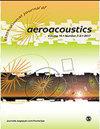Examination of air flow characteristics over an open rectangular cavity between the plates
IF 1.3
4区 工程技术
Q3 ACOUSTICS
引用次数: 0
Abstract
Air flow characteristics of an open cavity have been numerically examined by using different turbulence models of Detached Eddy Simulation (DES), k-ε Realizable, k-ω Shear Stress Transport (SST) and Large Eddy Simulation (LES) based on an experimental study of open literature. Numerical results of transient analyses have been compared to experimental results at cavity length-based Reynolds number of Re = 4600. Pressure distributions, streamline patterns, streamwise velocity components, mean velocity values and their vectors have been given in terms of contour graphics. Moreover, velocity profiles have been presented. Pressure fluctuations have been triggered by flow separation and its reattachment. Due to upstream separation of boundary layer, there was curved boundary layer obtained between the outer potential-flow-like and the recirculation zones. As a result, negative velocity values are evidence for rotational flows affected by formation of secondary flows in the cavity. Furthermore, lower pressure region has been observed as a result of rotational flow which was powerful in the open cavity. Numerical results of DES and LES turbulence models are in good agreement with the results of reference study. As the numerical results obtained by LES turbulence model are approximately same with those of experimental reference study, LES turbulence model is mostly recommended. As an option to these turbulence models, k-ω SST model could be utilized for limited computer capacity. However, k-ε Realizable model is not sufficient for capturing rotational flows which are very effective in terms of present case.平板之间开放矩形空腔内空气流动特性的检验
在开放文献实验研究的基础上,采用分离涡模拟(DES)、k-ε Realizable、k-ω剪切应力输运(SST)和大涡模拟(LES)等不同湍流模型,对开放腔内的气流特性进行了数值研究。将瞬态分析的数值结果与基于腔长雷诺数Re = 4600的实验结果进行了比较。用等高线图形给出了压力分布、流线形态、流向速度分量、平均速度值及其矢量。此外,还给出了速度剖面。压力波动是由流动分离及其再附着引起的。由于边界层上游分离,外势流区与再环流区之间形成了弯曲边界层。因此,负速度值是受腔内二次流形成影响的旋转流动的证据。此外,由于开腔内的旋转流动强大,还观察到低压区。DES和LES湍流模型的数值结果与文献研究结果吻合较好。由于LES湍流模型得到的数值结果与实验参考研究的结果基本一致,所以通常推荐使用LES湍流模型。在有限的计算机容量下,k-ω海温模型可以作为这些湍流模型的一种选择。然而,k-ε可实现模型不足以捕获旋转流,而旋转流在当前情况下是非常有效的。
本文章由计算机程序翻译,如有差异,请以英文原文为准。
求助全文
约1分钟内获得全文
求助全文
来源期刊

International Journal of Aeroacoustics
ACOUSTICS-ENGINEERING, AEROSPACE
CiteScore
2.10
自引率
10.00%
发文量
38
审稿时长
>12 weeks
期刊介绍:
International Journal of Aeroacoustics is a peer-reviewed journal publishing developments in all areas of fundamental and applied aeroacoustics. Fundamental topics include advances in understanding aeroacoustics phenomena; applied topics include all aspects of civil and military aircraft, automobile and high speed train aeroacoustics, and the impact of acoustics on structures. As well as original contributions, state of the art reviews and surveys will be published.
Subtopics include, among others, jet mixing noise; screech tones; broadband shock associated noise and methods for suppression; the near-ground acoustic environment of Short Take-Off and Vertical Landing (STOVL) aircraft; weapons bay aeroacoustics, cavity acoustics, closed-loop feedback control of aeroacoustic phenomena; computational aeroacoustics including high fidelity numerical simulations, and analytical acoustics.
 求助内容:
求助内容: 应助结果提醒方式:
应助结果提醒方式:


